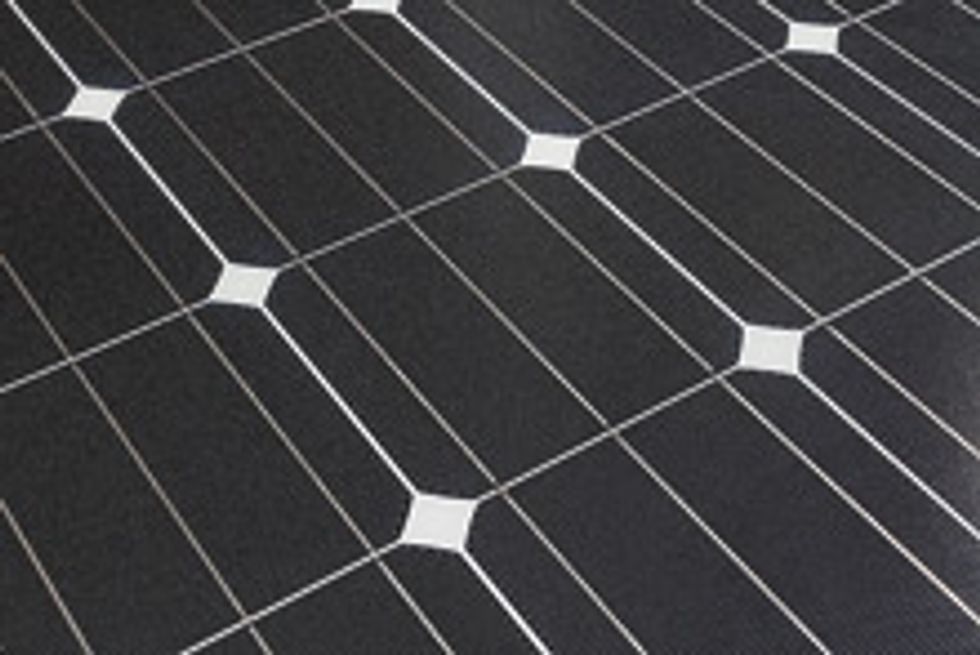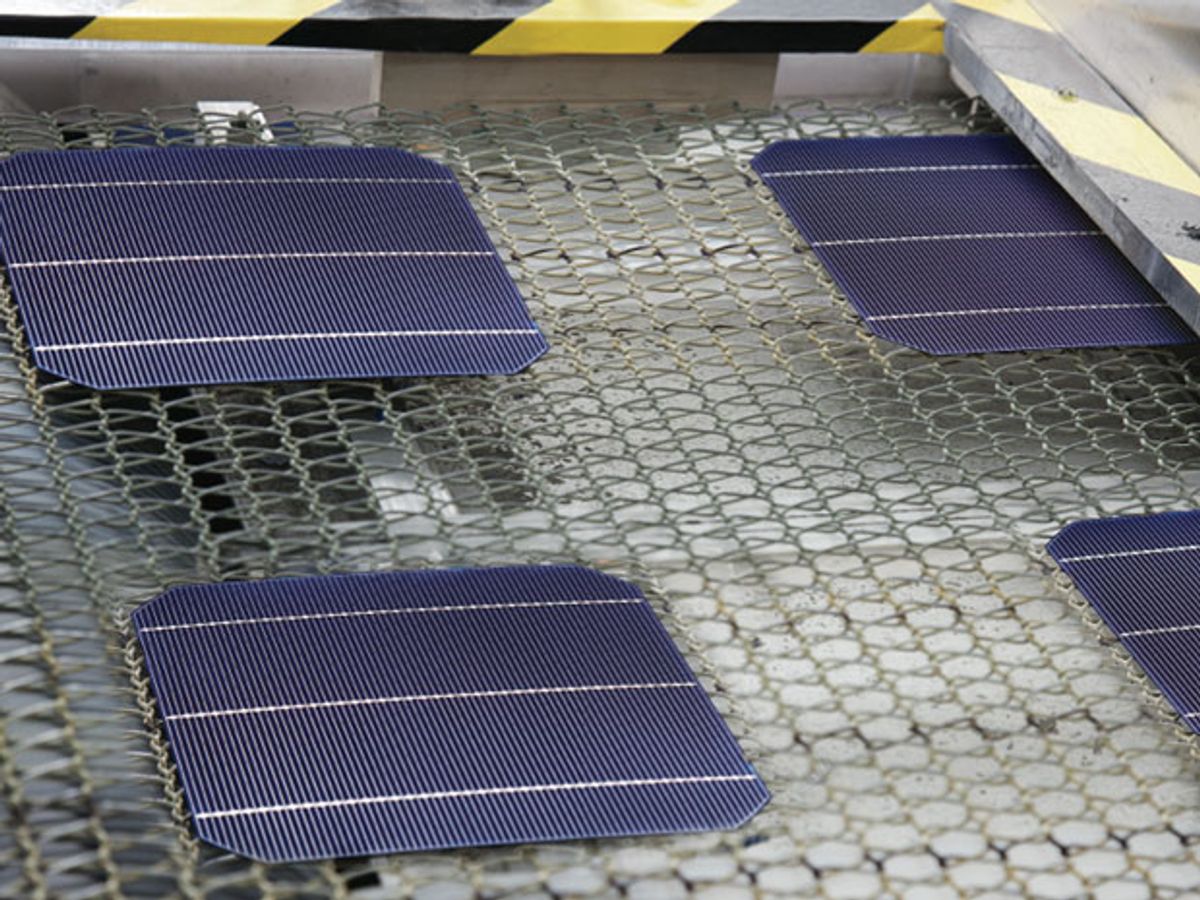In late March, solar-panel manufacturer SunPower Corp. announced that it was beginning limited production of its record-breaking crystalline silicon solar cell, which can achieve up to 24 percent conversion of the sun’s energy.
That record efficiency is just for individual solar cells, though, and the full panels SunPower makes will likely not get close to that mark: Typically, for these technologies, efficiencies rarely range above 16 to 18 percent. When you consider that the record efficiency for such a cell is over 27 percent and that the theoretical limit is around 29 percent, 16 to 18 percent doesn’t seem so great.
There are a number of reasons that solar-panel efficiencies are unable to approach those of the record-setting, or champion, cells, and they’re also the reasons that solar isn’t yet quite up to par, economically, with other energy sources. But the gap seems to be closing.
“Over time, the difference between the champion cells and what’s coming off the commercial production lines has been shrinking,” says Sarah Kurtz, a scientist with the National Renewable Energy Laboratory (NREL), the section of the U.S. Department of Energy that officially confirms solar-cell efficiency records. She cites some NREL data on monocrystalline silicon panel efficiencies from a sampling of companies: The average rose from 12.4 percent in April 2004 through 14.2 percent in April 2008, all the way to 15.4 percent last November. Over that same period, the record for such a cell has basically stood still.
The main reason that panel efficiencies can’t reach all the way to those of the cell records is size. A champion cell is just that—a cell: an individual, small bit of photovoltaic material that can use basically all of its area to convert sunlight into electricity. But you can’t power a home on an individual cell, you need a module: full panels with multiple cells that can actually be hooked to an electrical system. As soon as you try to combine a bunch of those cells into a module, there are significant losses.
“With a module, there are parts in between the cells; there’s the aluminum frame, things like that, and when you’re looking at a module, you’re taking into account that entire area,” says M.J. Shiao, a senior analyst with GTM Research, a market analysis firm based in Boston that focuses on green technology. In other words, not all of a solar panel is actually used to convert light to electricity.
Most crystalline silicon production lines average somewhere around 15 percent efficiency for full modules. Shiao says that manufacturers already have the technology to bump that toward 20 percent. One possibility is to use a textured solar cell to help trap light by reducing reflection; another is to use a rear-contact architecture, which basically allows cells to connect to their neighbors in a way that doesn’t cast a shadow on them. But for now, these techniques can’t be used at a cost that would make sense.

Companies also use manufacturing processes when they’re aiming for a record that are entirely different from those they use on an assembly line. “A champion solar cell, in general, needs to be essentially defect free,” says NREL’s Kurtz. “To get the highest efficiency, the materials need to be perfect.” Record cells typically need many extra processing steps: extra refinement of materials, smoothing out of imperfections, and so on. But in manufacturing, more steps mean more money; keeping the process simple is critical to holding down costs.
Bruce McPherson, vice president of R&D at photovoltaics firm Suniva, says one key to bringing the company’s cell production average up above 19 percent has been keeping extra steps out of the process, like using lasers to cut a groove into the edges of cells. “And frankly, we believe that there are further upsides that we see very clearly in the lab and are now working to get into manufacturing,” he says.
The difference between champion solar cells and their production line counterparts is still significant, though, and small improvements in individual steps or cutting out one or two along the line won’t jump a cell by 4 or 5 percent up toward a record. “Manufacturers are definitely all about getting a 0.1 percent efficiency gain using the same equipment,” Shiao says.
Some companies, though, have started to use the difference between record-setting cells and standard cells as a marketing tool. Suntech, Trina, Yingli Solar, and others now have what they’re calling “flagship lines” with names like Pluto, Panda, and Honey, that incorporate record-holding cells into more expensive modules.
But for mainstream modules, manufacturers will have to be satisfied with scraping away a tenth of a percent or so with each incremental improvement. That is, until something drastic changes—a new version of a process or a big enough drop in a material’s price to allow an extra processing step to be added.
The latter scenario may be going on right now. The price of a kilogram of polysilicon—the primary feedstock for crystalline silicon cells—dropped below US $30 in April from $80 in early 2011. This has contributed to a drop in the price of solar PV modules to below $1 per watt at the end of 2011, meaning there could be more room for adding those efficiency-improving steps to production.
Still, Kurtz says that major efficiency upgrades are becoming less likely, given the current overall solar market. “I think the efficiencies are going to continue to creep up, but the rate at which they creep up is primarily dependent upon the availability of the development funds, the R&D-type funding to make those changes,” she says. And such funding isn’t pouring in right now.
“But the difference between the record-efficiency cells and the module efficiencies is shrinking; that’s the big picture,” Kurtz adds. “And that’s going to continue to happen for a few years.”
